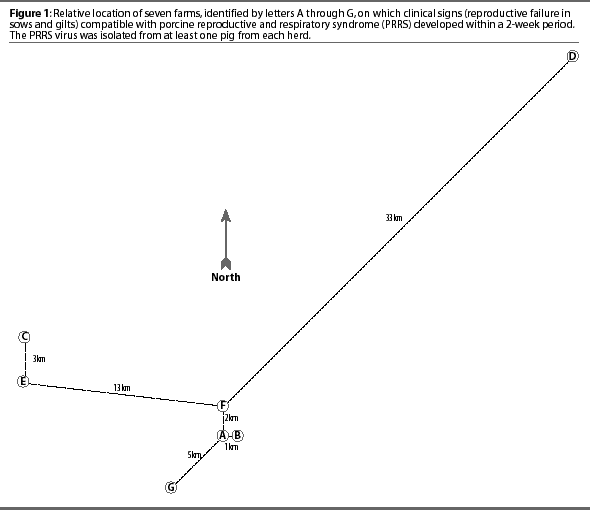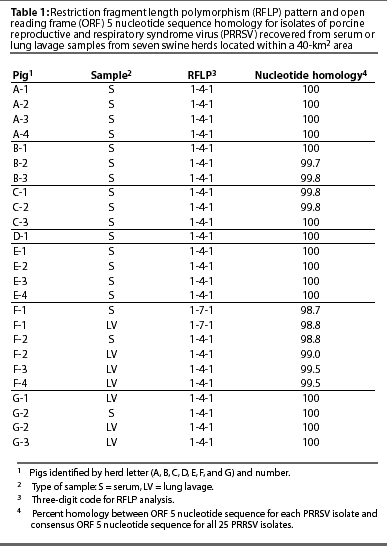Pork producers may need to consider the potential risk of PRRSV
area spread when making plans for locating and building new facilities.
P>The authors t
hank Deborah Adolphson and Deb Clouser for technical
assistance and Drs Craig Johnson and Steve Leppert for field
Disclaimer
Mention of trade names or commercial products in this article is solely for the
purpose of providing specific information and does not imply recommendation or
endorsement by the US Department of Agriculture.
References - refereed
1. Dee SA, Joo HS. Recurrent reproductive
failure associated with porcine reproductive and
respiratory syndrome in a swine herd. JAVMA.
1994;205:1017-1018.
2. Robertson IB. Transmission of blue-eared pig disease.
Vet Rec. 1992;130:478-479.
3. Stevenson G, Van Alstine W, Kanitz C. Characterization of infection with endemic porcine
reproductive and respiratory syndrome virus in a
swine herd. JAVMA. 1994;204:1938-1942.
8. Albina E, Madec R, Cariolet J, Torrison J.
Immune response and persistence of the porcine
reproductive and respiratory syndrome virus in
infected pigs and farm units. Vet Rec. 1994;134:567-573.
9. Wills RW, Zimmerman JJ, Swenson SL, Yoon KJ, Hill HT, Bundy DS, McGinley MJ. Transmission
of PRRSV by direct, close, or indirect contact. Swine Health Prod. 1997;5:213-218.
10. Yoon IJ, Joo HS, Christianson WT, Morrison RB, Dial GD. Persistent and contact infection
in nursery pigs experimentally infected with
porcine reproductive and respiratory syndrome
(PRRS) virus. Swine Health Prod. 1993;1(4):5-8.
11. Gradil C, Dubuc C, Eaglesome MD. Porcine reproductive and respiratory syndrome virus:
seminal transmission. Vet Rec. 1996;138:521-522.
12. Prieto C, Suarez P, Simmarro I, Garcia C,
Martin-Rollo S, Castro JM. Insemination of
susceptible and preimmunized gilts with boar semen
containing porcine reproductive and respiratory syndrome
virus. Theriogenology. 1997;47:647-654.
13. Yaeger MJ, Prieve T, Collins J, Christopher-Hennings J, Nelson E, Benfield D. Evidence for
the transmission of porcine reproductive and
respiratory syndrome (PRRS) virus in boar semen.
Swine Health Prod. 1993;1(5):7-9.
14. Torremorell M, Pijoan C, Janni K, Walker R, Joo HS. Airborne transmission of
Actinobacillus pleuropneumoniae and porcine reproductive
and respiratory syndrome virus in nursery
pigs. Am J Vet Res. 1997;58:828-832.
15. Amass SF, Stevenson GW, Anderson C, Grote LA, Dowell C, Vyverberg BD, Kanitz C,
Ragland D. Investigation of people as mechanical vectors
for porcine reproductive and respiratory syndrome
virus. Swine Health Prod. 2000;8:161-166.
16. Otake S, Dee SA, Rossow KD, Deen J, Joo HS, Molitor TW, Pijoan C. Transmission of
porcine reproductive and respiratory syndrome virus
by fomites (boots and coveralls). J Swine Health
Prod. 2002;10:59-65.
17. Lager KM, Mengeling WL, Brockmeier SL. Homologous challenge of porcine reproductive
and respiratory syndrome virus immunity in
pregnant swine. Vet Microbiol. 1997;58:113-125.
18. Wesley RD, Mengeling WL, Lager KM, Clouser DF, Landgraf JG, Frey ML. Differentiation of
a porcine reproductive and respiratory syndrome
virus vaccine strain from North American field strains
by restriction fragment length polymorphism
analysis of ORF 5. J Vet Diagn Invest. 1998;10:140-144.
20. Goldberg TL, Hahn EC, Weigel RM, Scherba G. Genetic, geographical and temporal variation
of porcine reproductive and respiratory syndrome
virus in Illinois. J Gen Virol. 2000;81:171-179.
21. Rowland RR, Steffen M, Ackerman T, Benfield DA. The evolution of porcine reproductive
and respiratory syndrome virus: quasispecies and
emergence of a virus subpopulation during infection
of pigs with VR-2332. Virology. 1999;259:262-266.
22. Domingo E, Escarmis C, Sevilla N, Moya A, Elena SF, Quer J, Novella IS, Holland JJ. Basic
concepts in RNA virus evolution. FASEB J. 1996;10:859-864.
23. Meng X-J, Paul PS, Halbur PG. Molecular
cloning and nucleotide sequencing of the
3'-terminal genomic RNA of the porcine reproductive and
respiratory syndrome virus. J Gen Virol.
1994;75:1795-1801.
24. Mardassi H, Mounir S, Dea S. Molecular
analysis of the ORFs 3 to 7 of porcine reproductive
and respiratory syndrome virus, Quebec reference
strain. Arch Virol. 1995;140:1405-1418.
25. Meng XJ, Paul PS, Halbur PG, Morozov I. Sequence comparison of open reading frames 2 to 5
of low and high virulence United States isolates
of porcine reproductive and respiratory syndrome
virus. J Gen Virol. 1995;76: 3181-3198.
26. Murtaugh MP, Elam MR, Kakach LT. Comparison of the structural protein coding sequences of
the VR-2332 and Lelystad virus strains of the PRRS virus.
Arch Virol. 1995;140:1451-1460.
27. Kapur V, Elam MR, Pawlovich TM, Murtaugh MP. Genetic variation in porcine reproductive
and respiratory syndrome virus isolates in the midwestern United States.
J Gen Virol. 1996;77:1271-1276.
28. Suarez P, Zardoya R, Martin MJ, Prieto C, Dopazo J, Solana A, Castro JM. Phylogenetic
relationships of European strains of porcine
reproductive and respiratory syndrome virus (PRRSV)
inferred from DNA sequences of putative ORF-5 and ORF-7 genes.
Virus Res. 1996;42:159-165.
29. Andreyev VG, Wesley RD, Mengeling WL, Vorwald AC, Lager KM. Genetic variation
and phylogenetic relationships of 22 porcine
reproductive and respiratory syndrome virus (PRRSV)
field strains based on sequence analysis of open
reading frame 5. Arch Virol. 1997;142:993-1001.
30. Indik S, Valicek L, Klein D, Klanova J.
Variations in the major envelope glycoprotein GP5
of Czech strains of porcine reproductive and
respiratory syndrome virus. J Gen Virol.
2000;81:2497-2502.
31. Yuan S, Nelsen CJ, Murtaugh MP, Schmitt BJ, Faaberg KS. Recombination between North
American strains of porcine reproductive and
respiratory syndrome virus. Virus Res. 1999;61:87-98.
32. Zimmerman JJ, Yoon K-J, Pirtle EC, Wills
RW, Sanderson TJ, McGinley MJ. Studies on porcine reproductive and respiratory syndrome virus
infection in avian species. Vet Microbiol.
1997:55;329-336.
References - non refereed
4. Keffaber KK. Reproductive failure of unknown etiology.
AASP Newsletter. 1989;1-9.
5. Loula T. Mystery pig disease.
Agri-practice. 1991;12:23-33.
6. de Jong MF, Cromwijk W, Van't Weld P. The new pig disease: epidemiology and losses in
the Netherlands. EEC Sem Rep New Pig Dis: Porc Reproduct Resp Syn
(PRRS). Brussels, Belgium. 1991;9-19.
7. Komijn RE, Van Klink EBM, Van der Sande WJH. The possible effects of weather conditions
on the spread of the new pig disease in the
Netherlands. EEC Sem Rep New Pig Dis: Porc Reproduct Resp
Syn (PRRS). Brussels, Belgium. 1991;29-30.
19. Mengeling WL, Lager KM, Vorwald AC, Wesley RD, Clouser DF. An update of research
at the National Animal Disease Center on current
field strains of Porcine Reproductive and
Respiratory Syndrome (PRRS) virus. Proc Allen D. Leman
Conf. 1997;138-145.
33. Otake S, Dee SA, Rossow KD, Moon RD, Pijoan C. Evaluation of transmission of PRRSV
by mosquitoes. Proc AASV. Kansas City,
Missouri. 2002;303-305.

 Received: August 2, 2001
Received: August 2, 2001
